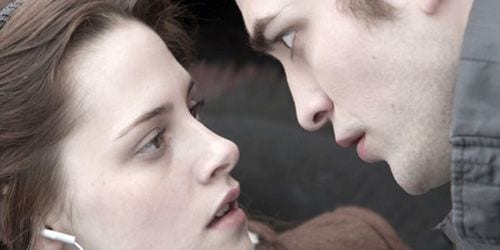
Twilight, the film based on the first book of Stephanie Meyers’ wildly successful young adult series, brings to life all the teen angst and vampire melodrama that fans were expecting. The Twilight craze has been in full effect ever since the announcement was made that a movie was forthcoming, and rabid fans embraced the adaptation.
The story focuses on Bella Swan (Kristen Stewart), a newcomer to Forks, Washington. Choosing to live with her estranged father Charlie (Billy Burke) after her mother’s recent marriage, Bella is sullen and antisocial and naturally, she immediately draws the attention of her entire new high school, particularly the attention of the mysterious Edward Cullen (Robert Pattinson). Edward and his equally mystifying family immediately stand out among the average high schoolers and Edward quickly makes Bella both curious and uncomfortable.
Immediately drawn to Edward, Bella soon discovers that Edward is not an average teenager, but rather a very old vampire, living undercover with a family of other vampires, and one with enough self restraint to deny his instincts to kill her.
The character of Bella is problematic in that while she may be clumsy and uninterested in being popular or in going to school dances – stereotypically girly interests – she still often ends up as the traditional girl-in-distress. Unfortunately, Bella is placed in situation after situation where she needs to be saved by Edward. Her helplessness is somewhat moderated by her otherwise independent spirit, but again, when it comes to Edward she is willing to put herself repeatedly at risk and frequently at his mercy.
While Meyers’ books tend toward fairly formulaic characterizations and simplistic dialogue, director Catherine Hardwicke takes the material and successfully transforms it into a more subtle and layered, atmospheric film than may have been expected. Hardwicke uses the setting of Forks for its maximum moodiness: the sun rarely shines, the rain is plentiful, and gorgeous greenery surrounds everything. An ideal environment for a vampire to hide in plain sight, Forks is also instrumental in serving as a place of startling change for Bella.
Previously living in Arizona, the newness of her environment serves as a gateway to the countless ways in which her life will never be the same. While never completely rising above some of the book’s weaknesses, Hardwicke does an admirable job of taking the story and running with it to produce a film with a bit more depth.
Twilight focuses on more than establishing the relationship between Bella and Edward. As Bella comes closer to understanding just what Edward really is and all that it entails, she is also the target of another vampire and her safety is never fully guaranteed. Hardwicke goes to great lengths to create a mood that speaks to impending danger while all the while managing to create an almost idyllic environment in which her leads can fall in love.
Throughout the commentary and in other special features, Hardwicke’s enthusiasm for the material is apparent. There is a bittersweetness to the fact that she will not be directing Twilight’s sequel, New Moon, as she is obviously very invested in the story.
Twilight relies heavily on its young actors to deliver challenging emotional depth and for the most part, they are up to the task. Stewart is especially good at playing Bella’s initial disaffection, as well as her growing fascination with Edward. Pattinson, carrying the heavy load of playing an almost impossible character, fares less well with an uneven, sometimes over-the-top performance.
Based on the documentary included in the special features, it is clear that Meyers had quite a bit of input into the film and Hardwicke, along with screenwriter Melissa Rosenberg, seem to have taken her suggestions very much into account. For instance, Meyers was concerned that a romantic scene between Bella and Edward was too intense and Hardwicke in turn, toned it down. Despite the fact that Hardwicke has publicly spoken out about many of the studio’s budgetary limitations on the film, especially related to special effects, there is little behind-the-scenes information on the topic.
Fans of the book series have surely already made their approval for the movie known and they will not be disappointed with the DVD treatment it gets. Bonus features abound in this special edition release, including: audio commentary by Hardwicke, Stewart, and Pattinson; deleted and extended scenes; music videos and performances by Muse, Paramore, and Linkin Park; a seven-part documentary on various aspects of pre-production, filming, and postproduction; and an edited look at Twilight at Comic-Con.
Overall, these special features add a great deal to the DVD release in highlighting and providing insight into certain choices made in this film adaptation. The commentary is a particular treat in that Stewart and Pattinson never take themselves too seriously and offer plenty of self-deprecating remarks, while Hardwicke explains many of the challenges (uncooperative weather, special effects, stunts, etc.) facing the production. This set that will surely please fans and provide more behind-the-scenes information to discuss and dissect.
